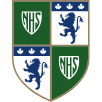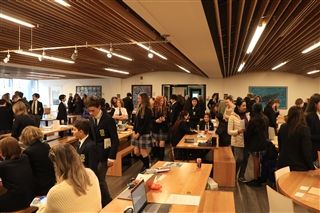This project format for the Grade 9 unit of the First World War was designed by this year’s Individuals & Societies teachers, Ms. Clark and Ms. Owen.
“The Grade 9 I&S curriculum has been built around the idea of stories as a way to learn about history, and museums play a critical role in telling those stories,” said Ms. Clark. “We are lucky to have some amazing resources through the Royal British Columbia Museum that we use for other units in the course, so in reimagining an inquiry-based unit on WW1, we came up with the idea of having students create their own museum. We were fortunate to have some guest speakers from the museum (including a GNS parent!) come to speak to the Grade 9s early in the unit and it was great to hear from experts in the field to get inspired. We specifically chose a format of a museum because we wanted a format that would allow all students to work collaboratively on a bigger project, with space for them to explore something they were really interested in. Museums are a great option because they allow us to consider what is historically significant and often that significance is determined by the story behind an object. We also wanted to create space for students to be really creative and think outside the box in coming up with their exhibits. Many of us have really fun memories of visiting all kinds of museums and we drew on those experiences to brainstorm the kinds of things that museums create to tell stories and teach visitors.”
The goal of the activity was to allow students to learn about WW1, to practice their research skills, to think about the idea of historical significance and to develop skills around project management that would help them with their personal projects next year. Staff drew inspiration from the planning and reflection aspects of the personal project and tried to mirror that in the unit so that students would have the experience of managing a project over several weeks, planning and adjusting that plan when necessary, and reflecting on the process throughout.
Students could choose an area of interest, within the umbrella topic of World War I, to research and eventually create an exhibit. The requirements for the project included collecting an artifact, writing a brief item label about the item, and recording an audio tour. Students also had to design a deliverable such as writing a brochure or curator’s statement. A wide range of topics were presented including trench warfare, fashion, women’s roles in society, nursing and medical advancements.
Reese Suntok ’26 said, “I think that being able to research our own topics allows for students to use their creativity and become more engaged with the project,” said Reese Suntok ’26. “It is also a great way for the students to learn about something they are interested in learning about.”
She admitted that the museum exhibition format was a lot more fun and enjoyable to do compared to writing a long essay. “I would definitely take doing this again over an essay.” she added.
“I think having projects that allow you to research about a topic of your choice is fun because it allows for a much greater variety of projects that might not have ended up happening if the topic was more controlled,” said Rem van Lierop ’26. He also agreed that the flexibility of the museum exhibition project allowed students to have freedom over their topic and choose how to represent what they learned about their topic.
Many students, such as Kate Roed ’26 and Clio Milwright ’26, thought that the exhibition was fun, entertaining AND informative.
“I like this activity very much,” said Kate. “It is not so rigid and the open topic selection can exercise my planning ability and learning ability to the greatest extent.” After being asked what she took away from the exhibition, she said, “I learned the importance of efficient cooperation. If everyone completes their work efficiently, cooperation will become pleasant and effective. Otherwise, cooperation will become a drag. I would happily do this project again, it was so much fun.”
“I really liked being able to come up with our own topics and gathering primary sources for my exhibition. I now have a copy of the 1888 English translation of the communist manifesto, and I enjoyed reading other political works for research,” said Judy Su ’26, “I think being able to pick something I’m passionate about as my topic was one of the main reasons I really enjoyed doing this project. I learned that autocratic systems of government probably aren’t the best idea in the long term. Also I learned that events in history often have a way of repeating themselves.”
“I liked the very wide range of topics we could research, and the creative way that we had to display the information,” said Clio Milwright ’26, “I felt that it was a more interesting way to apply our learning, and made it easier to imagine scenarios where our learning might be useful. I learned all about fashion during World War one, as that was my topic. However, as one would expect, there was a certain amount of bleed-through of general information about the war, like dates, major events, struggles, etc., so this project taught me about the war as a whole, as well as my personal interests. All in all, I did enjoy this project and would want to do it again IF we got more time to do so. The allotted time did not feel quite long enough, and I didn’t feel as though I’d completed my best work.”
Ms. Clark added that she would definitely do the museum exhibition project again. “We were so impressed with the exhibits and the knowledge that students came away with. They spoke with real fluency and confidence about their areas of focus and the creativity and variety of exhibits surpassed our expectations!”
Both students and teachers agreed that the project was successful in providing students with an opportunity to learn about the first world war and showcase their knowledge with creativity. With the museum exhibition being as successful as it was, next year’s Grade 9s should have a clear understanding as to what their WW1 project will be about.





